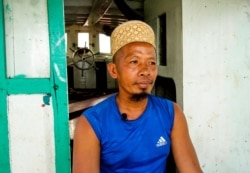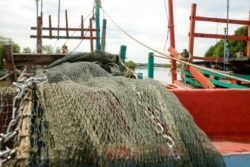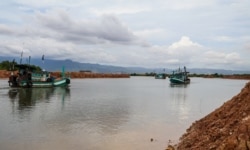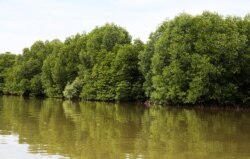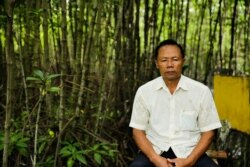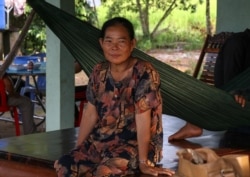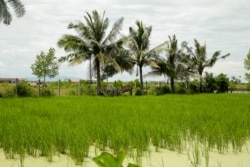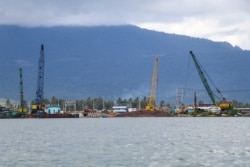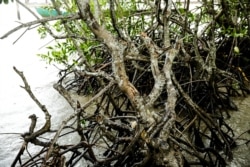Stronger Winds and Storms Make Coastal Fishing an Even Riskier Business
- Sun Narin
- Lors Liblib
- VOA Khmer
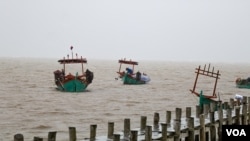
TRAPEANG SANGKAE, KAMPOT — Fisherman Mert Youb doesn’t want his teenage son to make his living at sea.
“I want him to study and become a teacher or do other work, because I think fishing at sea could be really risky in the future. I don’t want him to be like me,” Youb told VOA Khmer in September, at his home in Tuek Chhou district’s Kampong Kes village.
“Last month, there was a boat that sunk due to strong wind, but the fisherman was rescued on time,” he added.
Climate change is bringing more storms and strong winds to Youb’s coastal community, making life even tougher for fishermen already facing declining ocean life due to illegal fishing practices and unchecked development ravaging the seascape.
These days, Youb’s daily catch of shrimp, crabs, octopus and small fish is about equal to what he used to catch in shrimp alone — though higher prices for his haul means he still brings in about 90,000 riel ($22.50) in a 12-hour day.
Global experts say one major effect of global warming, more frequent and intense weather, will hit hardest in developing countries that rely on fishing for livelihoods and sustenance.
That’s already playing out in coastal zones in Cambodia, where sea levels are slowly rising and storms are adding a new element of danger to an already hardscrabble way of life.
Les Kert, another fisherman, said his teenage son dropped out of school and is now laboring on fishing boat, earning 30,000 riels ($7.50) to 40,000 riel ($10) per day. He said he also wanted his 15-year-old son to stay in school, “but he said he was tired of studying during COVID-19 and he wanted to help parents since he sees parents in difficult time.”
Kert agreed that his line of work is increasingly dangerous. “If there is rain or wind, it can risk our lives,” he said. “My wife always cries when we meet strong wind.”
Both Youb and Kert said rapid development of the coastline and illegal fishing practices like electrified nets and industrial-scale trawling — often by Vietnamese boats crossing into Cambodian waters — were largely to blame for their troubles.
“Before I could fish here, but now it has been filled with land so fish can’t live here,” said 48-year-old Kert, adding that he and his wife now fish off a nearby island.
But erratic weather and increasing temperatures are compounding their struggles.
“The weather has changed completely. In the past, we had the same strong wind, but it occurs predictably. But now it can happen at any time,” said Youb. “Sometimes, when we place nets in the sea for fishing, big waves come and make it difficult to fish.”
And they both worry about what it means for the next generation. “I think my younger generation can’t work at the state-run bodies with high positions,” said Youb. “So, they rely on fishing…If we lose places to fish, what can they hope for?”
“In the future, they can only work as laborer for others since they can’t fish at sea,” said Kert.
All of Cambodia is “highly vulnerable” to climate change, due to so many people living on the margins and limited government resources to help them, according to United Nations reports and the Cambodian government.
However, few areas are feeling the effects as strongly as the 450-kilometer coastline stretching from Kep to Kampot to Preah Sihanouk and Koh Kong provinces, where agriculture, fishing, tourism and shipping are all vulnerable.
Cambodia’s sea level could rise by more than half a meter by 2090, inundating 25,000 hectares and forcing thousands to relocate, according to the government’s 2013 Climate Change Strategic Plan. Temperature are expected to rise by between 0.13 and 0.36 degrees per decade.
According to a study on public perceptions of climate change in Cambodia, published earlier this year, people in the coastal region are “particularly vulnerable to the impacts of climate change.”
“They were the least likely to feel confident about preparing for extreme weather and the most likely to say they needed government support to address the changes they were experiencing,” says the study by National Council for Sustainable Development.
And yet coastal people were also “the most likely to say that they did not know how to take action,” it added, citing lower income and education levels as a possible explanation.
Sim Him, chief of Trapeang Sangkae fishery community, which has been turned into a community ecotourism site, said the changing climate was hurting humans and wildlife alike, noting recent storms knocked down 300 homes in the area.
And the rising temperate is reducing fish production, Him said. “Now there is an increasing heat related to climate change so fishermen lose income,” he added.
But the biggest threat to his community, which revolves around its mangrove forests, is disputes over who controls the land and sea, and the creeping threat of so-called development.
“There is an attempt to get our community’s land. If there is more and more encroachment, our community will be ruined,” he said.
Mov Chheang, Trapeang Sangke commune chief, said the number of fishing families have decreased, as locals go to work on construction sites or in factories.
“We put climate change in our five-year plan,” he said, meaning that more villagers were educated about climate change. The message was driven home in 2019 when storms destroyed a number of houses in the commune, he added.
Hak Mao, director of the Department of Climate Change of the Environment Ministry, said the government was aware that climate change would bring more serious storms and floods to the coast, but said it wasn’t keeping data on the current conditions.
“We just know that wind is more serious now since it is frequent,” he said.
For fisherman Les Nos, 37, its the unpredictability — of the weather, his daily catch, and his income — that has him on edge.
Every day he heads out on his motorboat at 5 a.m. and returns home to his fishing community in Kampot province at 10 or 11 p.m.
“Some days, I can catch around 5 to 7 kilograms per day. And some times, I can catch only a few kilograms of fish,” Nos said. During a bad stretch, it’s a struggle to come up with money to feed his kids — aged 2, 6 and 7 — and send them to school, he added.
And as the sea becomes increasingly choppy, he only sees things getting more dire. “I am concerned as the weather becomes worse and worse, I won’t be able to fish since there are big storms and waves,” he said.




